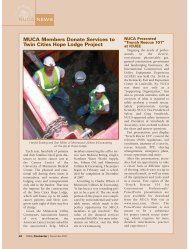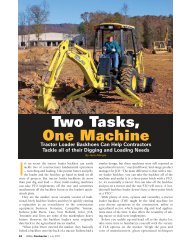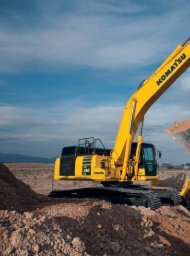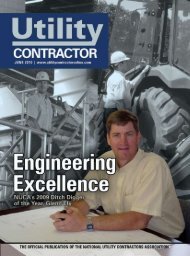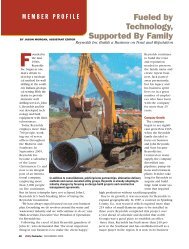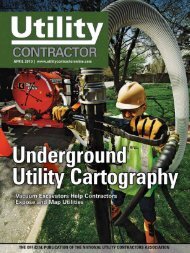View Full July PDF Issue - Utility Contractor Magazine
View Full July PDF Issue - Utility Contractor Magazine
View Full July PDF Issue - Utility Contractor Magazine
- No tags were found...
Create successful ePaper yourself
Turn your PDF publications into a flip-book with our unique Google optimized e-Paper software.
ida Underground, 40-ft interlocking sheet pile was chosenbecause of its strength and ability to resist water intrusion.Mabey engineers worked with Central Florida Undergroundreps to develop a scheme utilizing these sheets,along with Mabey’s Super PowerBrace frames and cornerstruts to produce a water resistant, yet easily installed cofferdamsystem.“Minimal water intrusion created some delay initially, dueto the tremendous pressure exerted on our sheets by thelake water,” says Richards. “Mabey salesperson Dave Howardworked with Mabey engineers to minimize water intrusionand ensure dewatering took place consistently to eliminatestanding water. Howard was onsite regularly, and CFU teamswere in contact with Mabey engineers throughout the durationof the project, to ensure success.”Once completed, the shored excavation measured 52 ftwide, 32 ft long and 22 ft deep. The system held back 9 ft ofwater and 8 ft of soil. After thoroughly dewatering the excavation,the installation was completed in less than 12 weeks.The Power of ShoringPro-Tec’s Massive Safe Trenching SolutionBy Dan Stupek“For sheer size and complexity, this was by far the biggestand most interesting trench shielding job I have ever been apart of, and I’ve been working with trench shield systems forover 25 years,” says Gary Carlson, President of Gary CarlsonEquipment of Blaine, Minn., the Pro-Tec shielding and shoringdistributor for the state of Minnesota.The trench shielding job Gary Carlson talked about was aslide rail system he and his staff designed and installed foran excavation and installation of twin 900-ft long pipelinesduring construction of a new power plant in St. Paul, Minn.The dual 84-in. concrete encased steel pipes came in 25-ftlengths, which were welded together inside and outside.Project owner XCEL Energy initially envisioned the 16-ft deep, 25-ft wide excavation to be completely walled offby tight steel sheeting supported by huge waler beams andspreaders, a time- and labor-intensive method, not to mentioncostly.Carlson’s crew had a better idea. Working with XCEL’sMike Bergquist and Scott Eddy, the Carlson firm submittedan alternative that met all criteria: worker safety; ease andspeed of installation; maximum pipe length allowance; andenough work space to allow pipe welding and grouting forboth lines side by side. The slide rail system was an integralfacet in the installation of the twin 900-ft long, 84-in. diameterwater intake and outflow pipes. Room to work was aproblem. Outside diameter of each pipe was 88 in. with 5 ftof space between the twin lines. The excavation for the twinpipes had to be installed in tight quarters, a right of waybarely 30 feet wide sandwiched between a river floodwalland a concrete paved street.Carlson’s design involved a slide rail system consisting of24-ft long by 8-ft high panels that were stacked to achievethe 16-ft depth and 25-ft spreaders positioned between custom-designed27-ft long vertical spreader posts. The sliderail shoring system was 130 ft long, 25 ft wide and 16 ftdeep. This system eliminated the need for huge walers orsacrificial beams (suggested by other plans), that alone savedan estimated $115,000.With the slide rail system, as each 25-ft pipe section iswelded, grouted and tested, that portion is backfilled andcompacted and the panels and spreaders are moved by theCAT 345 excavator to the front of the trench and reinstalledby a small crew. Because the system worked so efficiently,installation rates have exceeded initial estimates. The crewaveraged 25 ft of twin pipe per day. Instead of the six-monthtimeframe originally estimated, the job was completed injust over four months.The power plant was built along St. Paul’s riverfront by XCELEnergy, a Denver-based electric power utility. The new plant isnatural gas-fueled and replaced the 83-year-old High Bridgecoal-fired plant. The combined cycle plant produces electricityfrom two sources of energy. Natural gas is used as a fuel in acombustion turbine, similar to a jet engine. Then the exhaustgas from the turbine is used to make steam in a heat recoverysteam generator. The combined cycle is about 30-percentmore efficient than a traditional steam plant. The MERP plantis one of the largest construction projects in the upper Midwestthis year.Dan Stupek is the President of Fensholt Advertising, West Allis, Wisc.<strong>July</strong> 2009 | <strong>Utility</strong> <strong>Contractor</strong> 29




